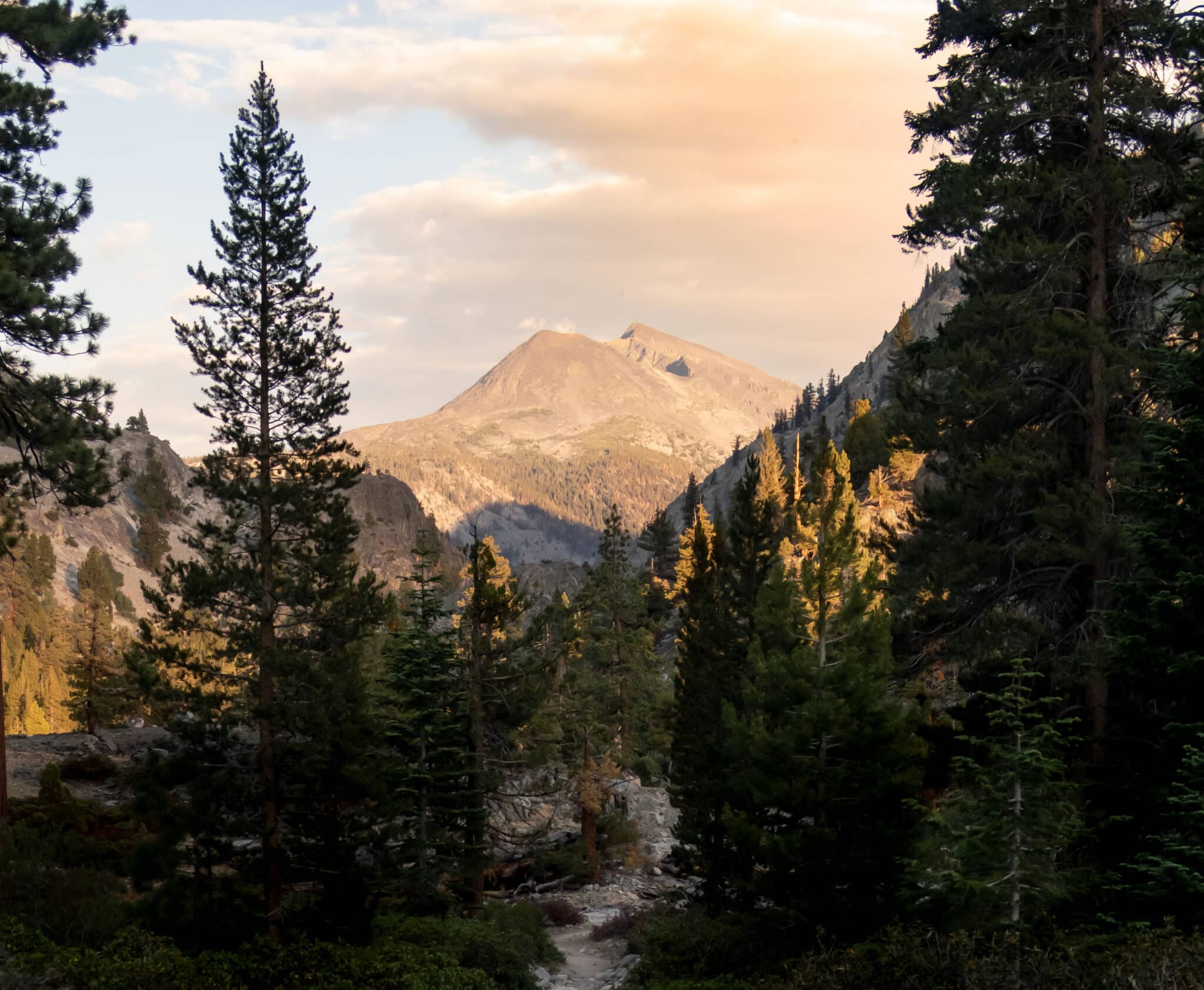5 PNW Backpacking Trips to Explore this Spring and Summer
The spring and summer months are perfect times to backpack the Pacific Northwest. But how do you choose one of the countless trails to explore?
This article includes five great options ranging in length from the massive PNT to a quick weekend trip around Mount Saint Helens. Each trail overview contains key information like distance from major cities, overall length, and links to more in-depth resources. They’re all located in the northwest region of the country, so if that’s where you’d like to explore, this list is for you.
Three Sisters Loop Trail
For a multi-day backpacking trip with fantastic views of volcanic peaks, head to central Oregon and tackle the Three Sisters Loop. You’ll experience a nice mix of terrain featuring lush forests, alpine meadows, and rocky canyons with waterfalls and flowing streams.
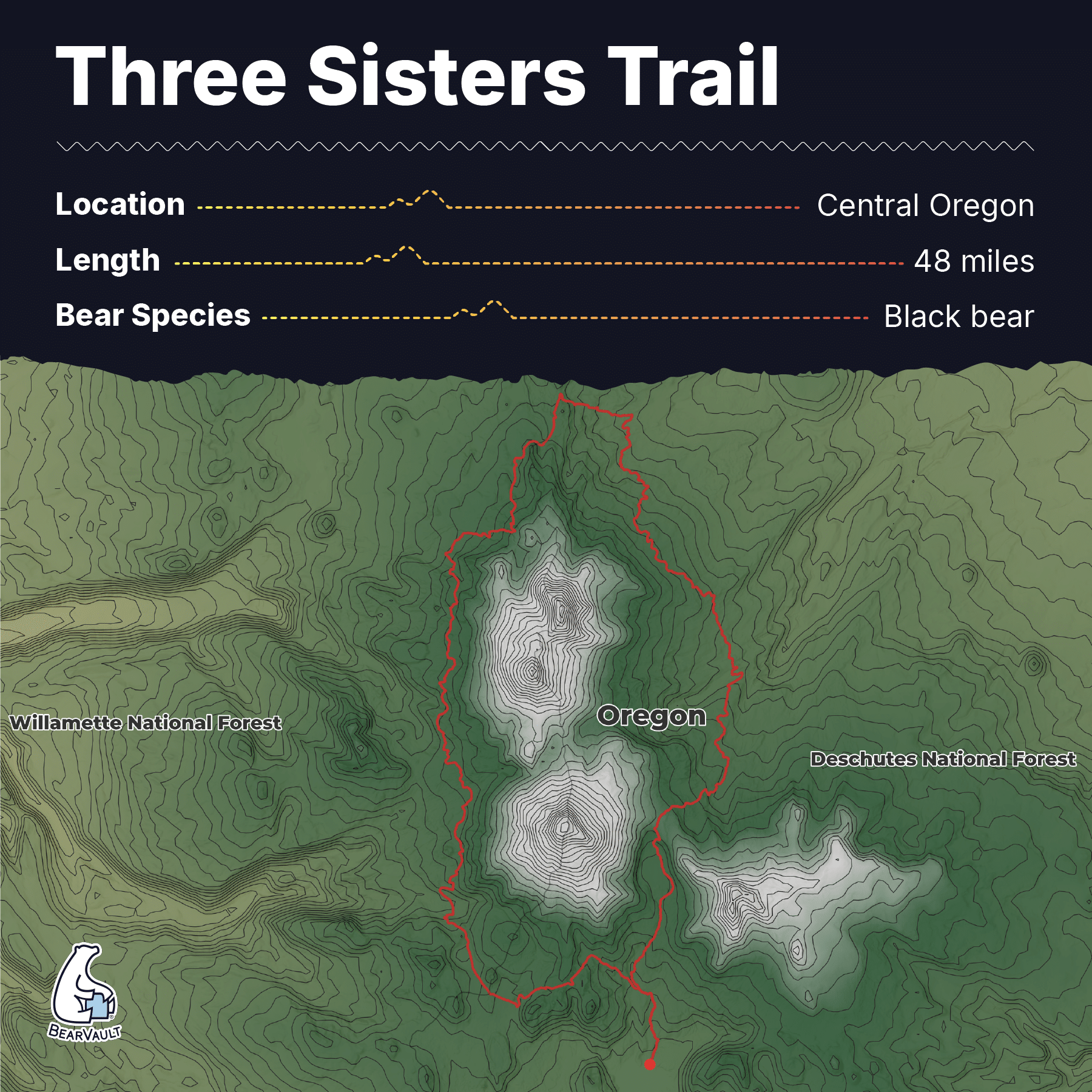
Where is the Three Sisters Loop located?
The Three Sisters Loop is located in central Oregon, running around the base of three iconic peaks in the Cascade Mountain range. The Lava Camp Lake Trailhead is located between Bend and Portland, Oregon.
How long is the Three Sisters Loop Trail?
The entire loop is 48.1 miles long, with multiple offshoots that can add extra miles if you choose to explore. Most backpackers should plan on it taking 3 or 4 nights.
Is the Three Sisters Loop a difficult hike?
Oregon Hikers call this trail ‘Difficult’ because it involves tricky descents into canyons and treacherous creek crossings. There are no developments, and the western portion of the loop can be dry, which is a concern for adequate hydration. However, the elevation gain is less than that of a similar hike around Mount Hood, and there are generally fewer crowds at Three Sisters.
Are permits required to backpack the Three Sisters?
The Three Sisters Loop Trail is located in the Central Cascades Wilderness, which requires permits for overnight stays. During the off-season, these permits are self-issued at the trailhead. From June 15 to October 15, permits are released on a rolling basis and must be reserved online beginning April 2, 2024.
Are there bears on the Three Sisters Trail?
Yes, bears do inhabit the Cascade Mountain range in central Oregon. The only species you could meet is the American black bear. You should practice responsible food storage to prevent the loss of your stash.
Are Bear Canisters Required on the Three Sisters Trail?
Though not required, backpacking with bear-proof food storage is always encouraged when in bear country.
For more information, check out this report from Oregon Hikers.
Olympic Coast Trail
The sound of crashing waves and seagull cries will be your soundtrack as you tackle this remote backpacking journey along Pacific beaches. This one is all about timing, and the tide will significantly impact your experience. It’s a challenging trail that offers unique features like petroglyphs and the towering green canopy of a majestic rainforest.

Where is the Olympic Coast Trail?
This trail is located in Olympic National Park and runs along the coastline of Washington. The northern terminal is roughly 180 miles from Tacoma, Washington. The southern terminal is 177 miles from Tacoma.
How long is the Olympic Coast Trail?
The Olympic Coast Trail is comprised of southern and northern sections and covers a total of roughly 54 miles. The tides can sometimes add to the overall mileage by forcing overland travel. The north section often requires 3-5 days, while the southern section can usually be traversed in 2-3 days.
Is the Olympic Coast Trail difficult?
The trail is considered difficult, mostly due to topography and tidal considerations. But it can be surprisingly challenging physically as well, in spite of the lack of elevation gain. Backpacking on long stretches of sand is no walk in the park. Neither is traversing steep, cable-assisted overland passes. The reward is in the ocean views and lush vegetation.
Are permits required to hike the Olympic Coast Trail?
All overnight stays require a permit in Olympic National Park. Reservations should be made in advance, with summer permits becoming available on April 15, 2024.
Are there bears on the Olympic Coast Trail?
Yes, black bears do inhabit Olympic National Park.
Are Bear Canisters Required on the Olympic Coast Trail?
Approved bear canisters are required in several areas within Olympic National Park, including the Wilderness Coast Trail area. Keep all food, garbage, and scented items in your canister when you’re not using them. For more information, explore this report about the North Coast Route and this review of the South Coast Route.
Pacific Northwest Trail
Are you looking for a backpacking adventure that keeps you on the trail for months but isn’t part of the Triple Crown? Do you want to spend all that time without a single day in the desert south? If so, you may want to head north to tackle one of the United States’ newest National Scenic Trails.
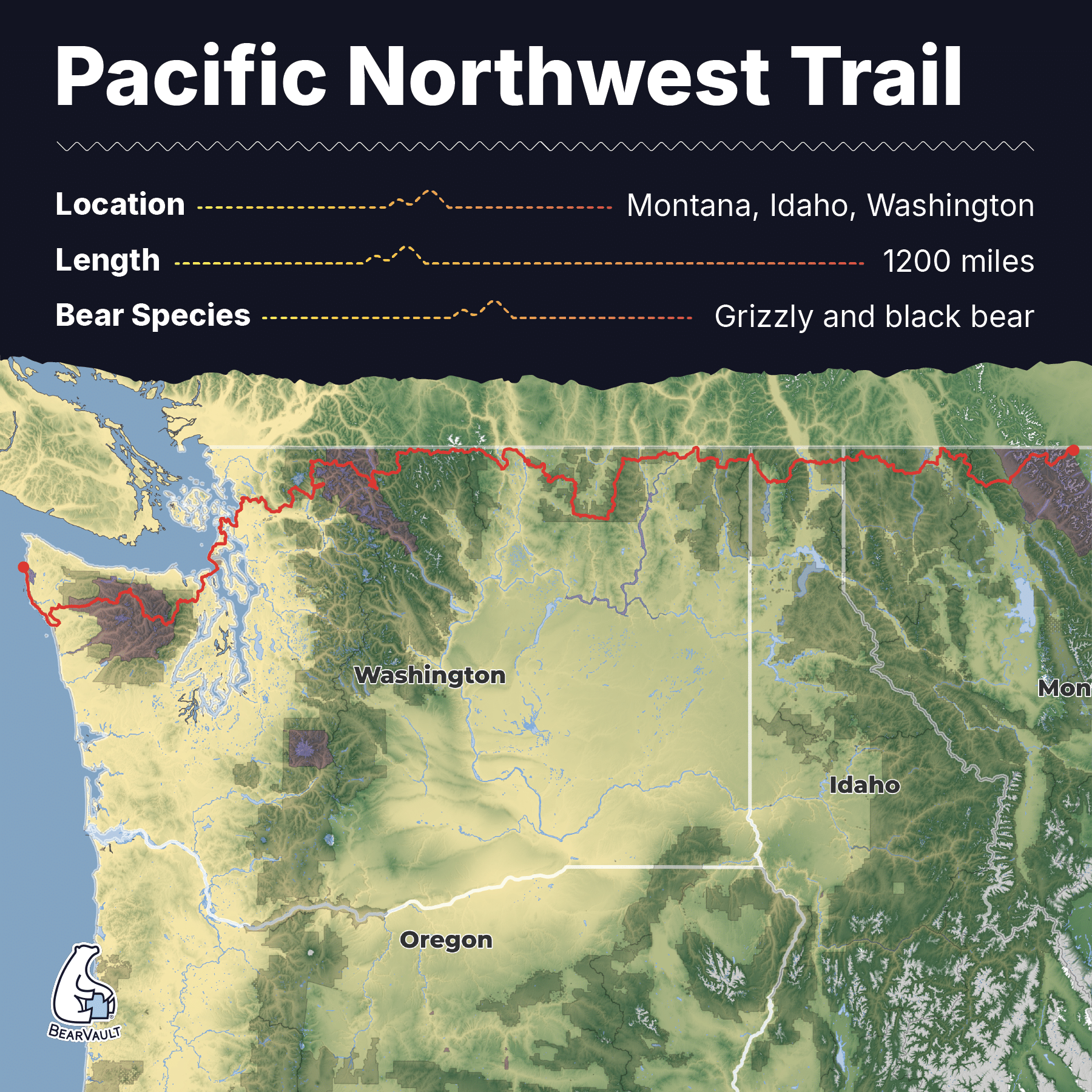
Where is the Pacific Northwest Trail?
The PNT runs from Glacier National Park to the westernmost point of the lower 48 at Cape Alava, Washington. Its eastern terminus is roughly 85 miles northeast of Kalispell, Montana. It ends about 186 miles northwest of Seattle, Washington.
How long is the Pacific Northwest Trail?
The total length of the PNT is 1,200 miles. The average thru-hike will take anywhere from 60-90 days, averaging 15-20 miles a day.
Is the Pacific Northwest Trail difficult?
Walking 15-20 miles a day for months on end is going to be difficult, period. But the PNT also gives you over 205,000 feet of elevation change and countless river crossings. And yet, it’s breathtaking in the best of ways, too. Prepare well, and you’ll have the time of your life.
Are permits required for the Pacific Northwest Trail?
Since it runs through so many different national parks and designated wilderness areas, there are numerous permits you’ll have to manage for a thru-hike. You’ll also need to keep your passport handy. Since the trail runs so close to the US/Canada border, border guards on patrol may require proof of citizenship.
Are there bears on/in the Pacific Northwest Trail?
Bears inhabit all of the PNT’s territories. Black bears live throughout, while grizzlies are contained to specific portions.
Are Bear Canisters Required on the Pacific Northwest Trail?
Yes, you will need a bear canister to thru-hike the PNT. National parks require bearproof food storage, and Olympic National Park does not approve soft-sided food storage like Ursacks or other hang bags. Visit the Pacific Northwest Trail’s website for more information. You’ll find all the information you need to plan your next adventure.
Devil’s Dome Loop
Do you have a long weekend coming up and want a backpacking trip that fits into that window? Challenge your quads in the northern Cascade Mountain range on this perfectly-lengthed loop trail. Breathtaking panoramic views from mountaintop campsites and peaceful forested trails combine to make this the ideal multi-day hike in Washington.
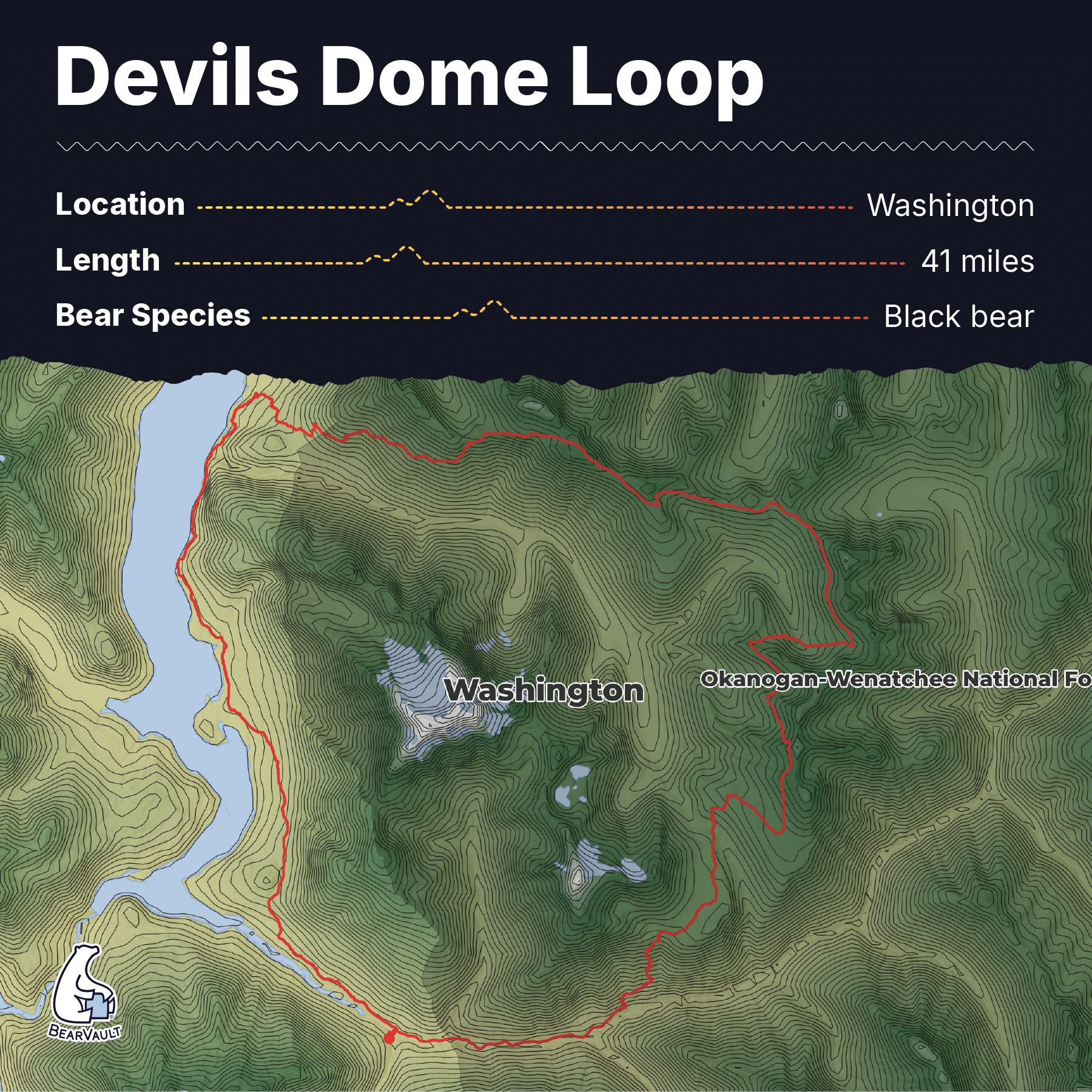
Where is the Devil’s Dome Loop?
This loop trail stays almost entirely within the Pasayten Wilderness, circling Jack Mountain. East Bank Trailhead is roughly 160 miles northeast of Seattle, WA.
How long is Devil’s Dome Loop?
The trail is 41 miles long and is usually tackled in 3 or 4 days. Take the 10,000+ elevation gain into consideration as you determine your goals.
Is Devil’s Dome Loop Trail difficult?
You can expect lots of ascending and descending and some dry stretches in this loop. The peaks can also be treacherous with loose shale, but the meadow and forested stretches are simple to navigate and hike.
Are permits required for Devil’s Dome Loop?
Staying overnight in certain sections of the loop requires a permit. Determine where you intend to make camp before you start this hike. If it’s within North Cascades National Park, you’ll need a permit. If it’s in a national forest, you don’t.
Are there bears on Devil’s Dome Loop?
Black bears are often sighted along this trail and hikers should stay bear aware.
Are Bear Canisters Required on Devil’s Dome Loop?
No, bear canisters are not required. However, since much of the trail won’t accommodate hangs and bears do inhabit the area, using a canister is encouraged. For more information and to read trip reports, check out the Washington Trails Association website.
Loowit Trail Loop
For a quick but challenging hike, circumnavigate the most active volcano in the Cascades mountain range. Don’t underestimate the challenge of this shorter hike. You’ll be able to complete it in only a couple of days and enjoy stunning views while you do, but it will require excellent navigational skills and the ability to traverse sketchy footing.
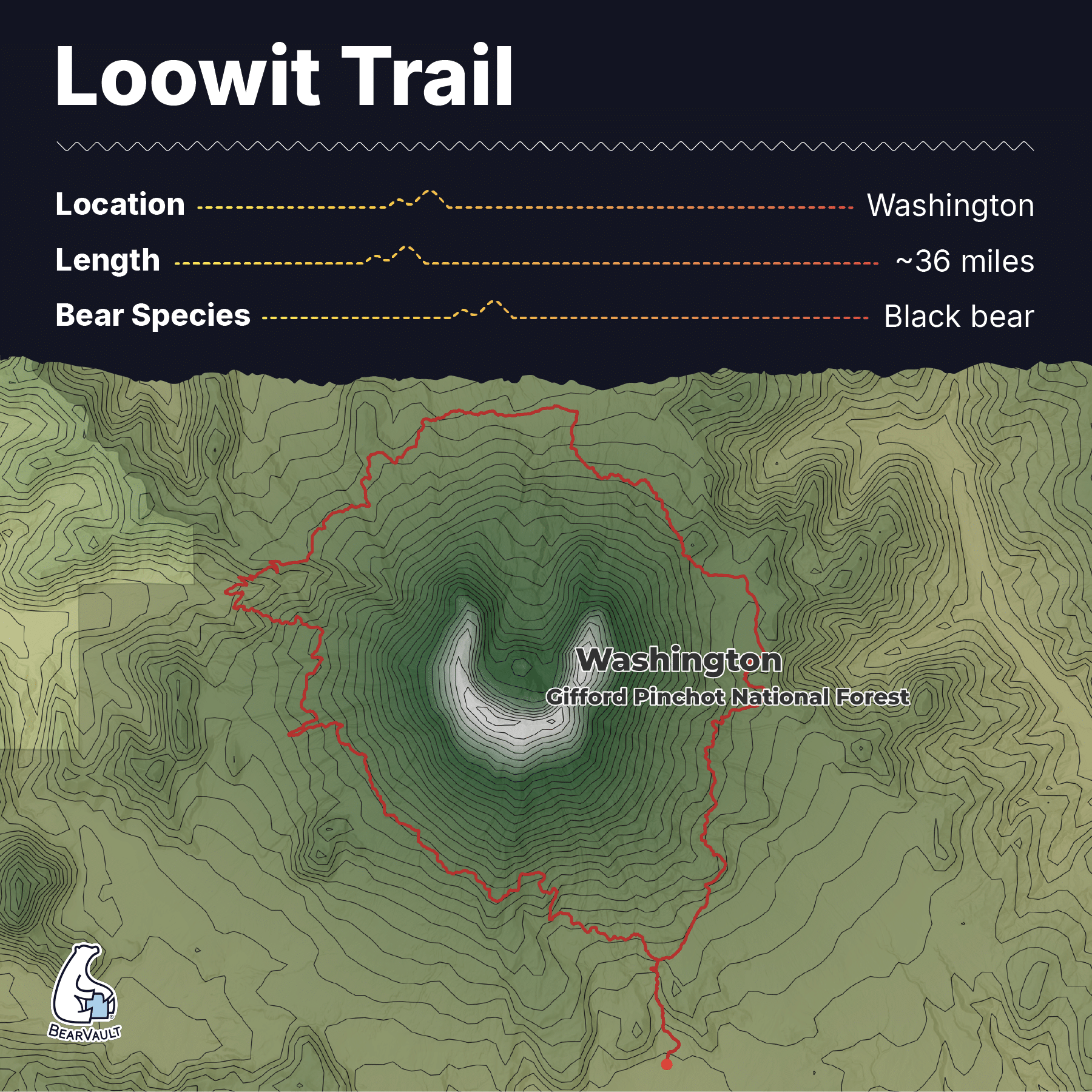
Where is the Loowit Trail Loop?
This loop trail runs around Mount Saint St Helens, partway between the foothills and the summit. You’ll find a trailhead about 75 miles northeast of Portland, OR.
How long is the Loowit Trail Loop?
Depending on which trailhead you choose to start with, the loop will be 30-36 miles. Most backpackers dedicate 2-4 full days of hiking.
Is the Loowit Trail Loop difficult?
This trail is considered very challenging with hard-to-find water, tricky navigation, and sketchy footing in sections.
Are there bears on Loowit Trail Loop?
Black bears can be found throughout Oregon and hikers should stay bear aware.
Are Bear Canisters Required on Loowit Trail Loop?
There are no food storage requirements on this trail, but you are always encouraged to store your food responsibly when in bear country. Much of the trail lacks adequate trees for hanging food. Using canisters can keep your stash secure in these sections. You can find more information, including trail alerts and regulations, at the US Forest Service site.
Happy Trails
Don’t forget to keep these wild places wild by practicing safe food storage and leaving no trace. Generations of backpackers to come will thank you in future years. Enjoy your spring backpacking adventures, fellow outdoorists!
Author Profile

Jessica Cockroft
Jess merges her passion for words and an insatiable longing for adventure as an outdoor freelance content writer and marketer. When she’s not busy stringing words together you’ll probably find her planning another camping trip for her crew of kids or taking care of the homestead. You can find her on LinkedIn and Instagram, as well as on her own website.

